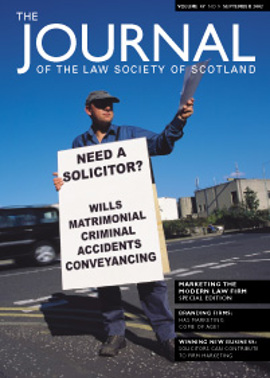Plain speaking
Almost every day I see letters where it is unlikely the “writer” has written the letter: Instead, he has probably dictated it so that a typist may type the letter and then send it back for the “writer” to sign. Unfortunately, often that is all the “writer” does. He doesn’t check the letter too carefully and assumes it sets out what he dictated. This is why Sheriff Officers were told to proceed to a “pointing”, an offer to buy land referred to a “laxative” plan, someone was preparing a “reporting note” and someone else was going to “recall the degree”.
We all make these unfortunate mistakes. (I have to review my own files often enough to know there are plenty of my bad examples out there!) However, one small mistake can ruin a letter, so we need to take care. To put it another way, we cannot afford to take our letters for granted.
The situation will gradually change as more fee earners become responsible for actually producing their own letters. I hope it will change for the better, but there is a drawback. More experienced typists wouldn’t hesitate to change a dictated letter so that it made sense. Apocryphal evidence suggests this was especially true in the larger, traditional law firms where long serving typists were keen to put young solicitors in their place. But if you are writing your own letters, you no longer have that hidden benefit; there’s nobody else to blame. I believe if you are producing your own letters, it’s even more important to take up the plain language challenge.
In this column I want to mention another important feature of plan language: sentence length. First, here is a quote from Gower’s “The Complete Plain Words” to set the scene:
“A sentence is not easy to define. Many learned grammarians have tried, and their definitions have been torn in pieces by other learned grammarians. But what most of us understand by a sentence is what the OED calls the ‘popular definition’: ‘such a portion of composition or utterance as extends from one full stop to another’. That definition is good enough for our present purposes…..
The two main things to be remembers about sentences by those who want to make their meaning plain is that they should be short and should have unity of thought.”
Most plan language authorities recommend we write sentences which average 15-20 words. As you can probably guess, the most common problem with sentences and writing is sentences that are too long. Of course, there’s a time and a place for a short sentence. But some people seem to think that only long sentences are good enough.
In my office, a letter with a 126-word single sentence paragraph holds the current record. That poor paragraph was in good company though; the writer sent it out with a 53-word and a 47-word sentence to stop it from being lonely. I can only guess why the writer wrote such a bad letter. While I can understand pressure of business probably played its part, I wonder how much extra time it cost him to explain the letter to his client. Based on personal experience, if I were to offer a prize for the longest sentence in a recent lawyer’s letter, I suspect I would be flooded with entries. Indeed, I won’t be surprised if there’s a new record for the longest sentence by the time the Journal prints this column. That is not a situation we should be happy about, or proud of.
However, it’s important to stress the target length is an average of 15-20 words. Short sentences can be effective. But too many short sentences are just as bad as too many long sentences. For example:
“The new law came into force on Monday. On Tuesday a lawyer challenged it. The challenge was under the Human Rights Act. On Wednesday the Minister responsible issued a statement. On Thursday the Prime Minister said his hands were tied. On Friday the Times’ editorial criticised the government.”
The paragraph is difficult to read, childish and – because the rhythm is so repetitive –makes it difficult for the reader to know what ideas the writer believes are more important than others. This example highlights the need to mix long and short sentences so that the rhythm doesn’t drive the reader to distraction. In other words, we shouldn’t write to a formula with every sentence being 15-20 words. Instead, we should use our judgement and our writing skills to write sentences of the appropriate length to get our message across to the reader:
In summary:
- Aim for an average sentence length of 15-20 words;
- Mix long and short sentences so the rhythm is not monotonous.
More reading
Put it in Writing, by Albert Joseph, McGraw-Hill (1998); ISBN 0 07 039308 7: this is an excellent, easy to read book about how to write clearly, quickly and persuasively.
In this issue
- Marketing through the ages
- Making the most of marketing
- Firms embrace merits of marketing
- Marketing methods for smaller firms
- Investing in people brings rewards
- Time to learn from enlightened English courts?
- Distinction between threatened and completed wrong
- Make it policy to know about policy cover
- In practice
- Plain speaking
- Book reviews






